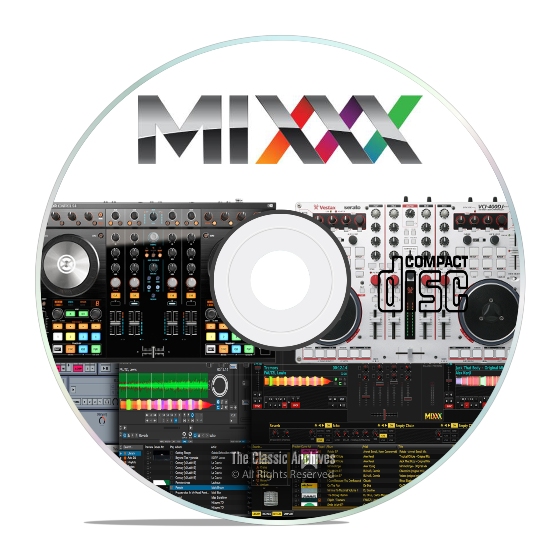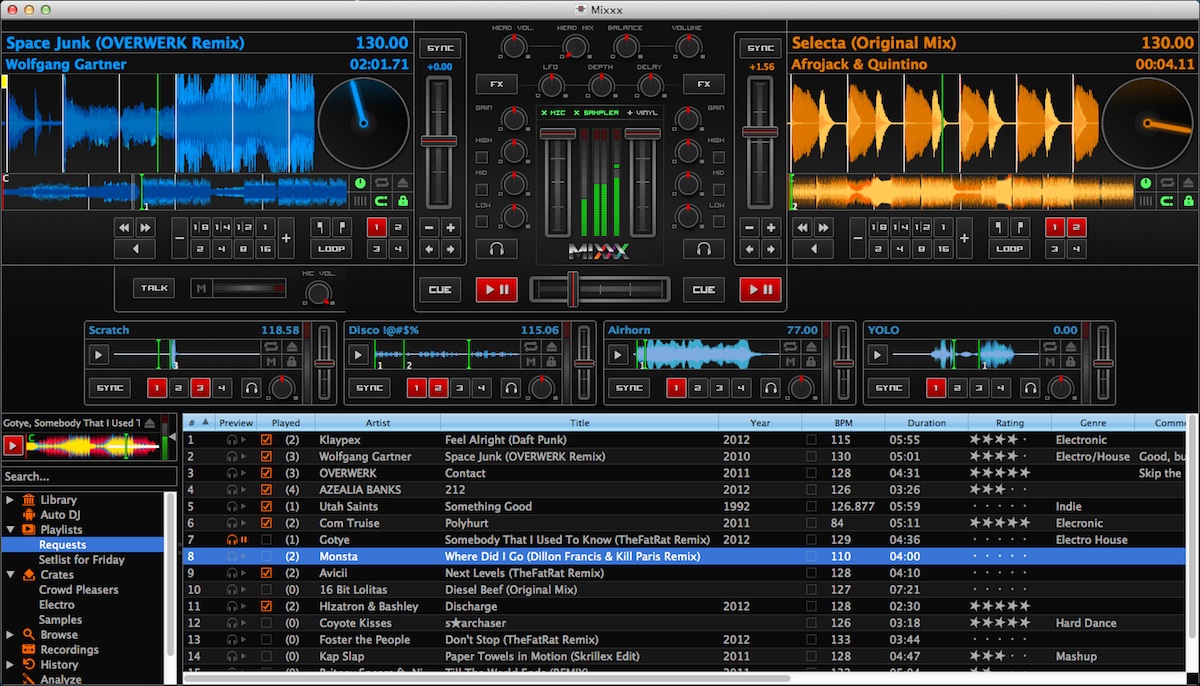Ddj 400 Mixxx

Buy the new Pioneer DDJ-400 DJ Controller with Rekordbox DJ Software. Familiar Club-style layout with built in Built-in sound card, Microphone Input and full Rekordbox License. May 11, 2019 how to download mixxx- Free Dj Mixixng software!! 2019 Mixxx is free and open-source software for DJing.2 It is cross-platform and supports most common music file formats. May 13, 2019 Anybody got a mapping for the new Pioneer DDJ-400 Great controller and it comes with Rekordbox as well. It's a shame though it doesn't work very well with Rekordbox. 2019 10:40 pm. Hi, I'm working on a midi preset for Mixxx. It should be in a alpha state in a couple of weeks I think. When it's ready I'll hope there a some testers around.
| Browser section (p. 6) | ||
|---|---|---|
| No. | Control | Function |
| 1 | [LOAD] buttons | loads the selected tracks to the respective decks |
| 1 | [LOAD] buttons pressed twice | Not yet mapped. (instant double / Clone from deck) |
| 1 | [SHIFT] + [LOAD] button (left) | Not yet mapped. (Sort library by criteria) |
| 1 | [SHIFT] + [LOAD] button (right) | Not yet mapped. (enlarge / shrink library view) |
| 2 | Rotary Selector | Turn to move track list cursor up/down. |
| 2 | Rotary Selector Press / [SHIFT] + press | cycle focus between folder view an track list |
| 2 | [SHIFT] + Rotary Selector | Turn to zoom in or out the Waveform on the Deck which Shift button is pressed |
| Deck section (p. 6 - 7) | ||
| No. | Control | Function |
| 1 | [BEAT SYNC] button | Match tempo and phase of other deck. Long press to enable Master Sync. |
| 1 | [SHIFT] + [BEAT SYNC] button | Cycle tempo fader ranges between 6%, 10%, 16% and 25% |
| 2 | [CUE/LOOP CALL >] button | Selects and calls out a cue point or loop point in the Track; while playing a loop doubles the loop length |
| 2 | [SHIFT] + [CUE/LOOP CALL >] button | Not yet mapped. (saves cue point while not playing, when playing a loop it saves the loop) |
| 3 | [CUE/LOOP CALL <] button | Selects and calls out a cue point or loop point in the Track; while playing a loop halves the loop length |
| 3 | [SHIFT] + [CUE/LOOP CALL <] button | Not yet mapped. (deletes a cue or loop point) |
| 4 | [RELOOP/EXIT] button | resume the previously set loop or while playing a loop: cancels the loop playback |
| 4 | [SHIFT] + [RELOOP/EXIT] button | jump to the beginning of the loop and stop playing |
| 5 | [OUT] button | sets the Loop Out point and the loop begins |
| 5 | [OUT] button (hold) + [JOG WHEEL] | while holding down the button when a loop is playing, adjust the position of the Loop Out point using the jogwheel |
| 6 | [IN/4BEAT] button | sets the Loop in Point |
| 6 | [IN/4BEAT] button (hold) + [JOG WHEEL] | while holding down the button when a loop is playing, adjust the position of the Loop In point using the jogwheel; while not playing a loop enable a 4 Beat loop |
| 7 | [JOG WHEEL] (top) | When Vinyl Mode is enabled activates the scratch mode when touched; When Vinyl Mode disabled pitch bend |
| 7 | [JOG WHEEL] (outer) | pitch bend |
| 7 | [SHIFT] + [JOG WHEEL] (top) | move Play position with higher speed in the direction the Wheel is turned |
| 8 | [HOT CUE] button | Sets the Performance Pads to hot cue mode see Performance Pad section |
| 8 | [SHIFT] + [HOT CUE] button | Sets the Performance Pads to key board mode see Performance Pad section |
| 9 | [BEAT LOOP] button | Sets the Performance Pads to beat loop mode see Performance Pad section |
| 9 | [SHIFT] + [BEAT LOOP] button | Sets the Performance Pads to PAD FX 1 mode see Performance Pad section |
| 10 | [BEAT JUMP] button | Sets the Performance Pads to beat jump mode see Performance Pad section |
| 10 | [SHIFT] + [BEAT JUMP] button | Sets the Performance Pads to PAD FX 2 mode see Performance Pad section |
| 11 | [SAMPLER] button | Sets the Performance Pads to Sampler mode see Performance Pad section |
| 11 | [SHIFT] + [SAMPLER] button | Sets the Performance Pads to Key shift mode see Performance Pad section |
| 12 | [TEMPO] slider | Adjust the track playing speed (can be adjusted via [SHIFT] + [BEAT SYNC] |
| 13 | [PAD] button | see Performance pad section |
| 14 | [PLAY/PAUSE] button | Plays/pauses a track in the respective Deck |
| 15 | [CUE] button | depends on the cue mode set in the Mixxx preferences |
| 15 | [SHIFT] + [CUE] button | Return to beginning of the track |
| 16 | [SHIFT] button | change the function of another control |
Description
DDJ-400 works with other MIDI-compatible software besides rekordbox, by assigning MIDI message. Please refer to the list of MIDI message to find mapping values of all buttons and knobs. To assign MIDI message to all software function, please refer to your manufacturers' software manual.
Apr 22, 2018 BEGINNERS ONLY In the third of five free sample lessons from the Digital DJ Tips 'intro' course for new users of Pioneer DJ's DDJ-SB2 (and SB and SB3), you'll learn how to hook up your. Mixxx 2.0 supports Pioneer DDJ-SB and DDJ-SB2. I also discovered DJing a year ago and got myself a DDJ-400 because of this, since I find the idea of mixing the songs I love for a crowd that shares my sentiment towards them liberating and fulfilling. Pioneer - DDJ-WeGO4 - Layout Mixer & Browser Controls. CROSSFADER: Blends audio (& video if LINK is enabled from the VIDEO panel of VirtualDJ 8 GUI) between the left and the right VirtualDJ decks. VOLUME: Channel Volume Faders. Faders alter the sound of the left and right software deck.
This is my attempt at mapping the Pioneer DDJ-SR for Mixxx.
This was originally written for Mixxx v1.11.0, but I'm in the process of updating it to Mixxx 2.0 as of January 2017. This is very much a hobby project though, so updates may be intermittent.
How do I use it?
If you just want to get your controller working with with Mixxx without bothering about the details much, then do the following:
- Download the following two files:
- Copy these to the
[Mixxx Directory]/controllersfolder. This will probably be one of the following locations:- Windows:
C:Program FilesMixxxcontrollers - Linux:
/usr/share/mixxx/controllers or /usr/local/share/mixxx/controllers - OS X:
/Applications/Mixxx.app/Contents/Resources/controllers/
- Windows:
- Make sure your Pioneer DDJ-SR is plugged in, turned on, and set up to use DJ software other than Serato (see your user manual, or the
Controller Setupsection below) - Open (or restart) Mixxx, and enjoy using your (semi-functional) controller
Ddj 400 Mixing
Controller Setup (important!)
By default, your Pioneer DDJ-SR will be in 'Serato-mode'. This means that some functionality quite simply won't work in Mix until you turn it off (for example, keylock for the pitch controls). /izotope-rx-post-production-suite-1.html. To change this, do the following.
- Turn off the Pioneer DDJ-SR
- Hold down
Shift+Playon the left deck, and turn the power on. - Turn the left deck's keylock on.
- Restart the controller.
To use the controller with Serato again, repeat this process and turn the keylock back off again.
What's implemented?
- General
- Cross-fader
- VU Meter LEDs
- Deck Controls
- Volume
- Play / pause
- EQ
- Highs
- Mids
- Lows
- LPF / HPF Filter
- Cue button
- Sync button (although this works differently than in Serato; still to be fixed)
- Performance Pads
- Hot Cues
- Rolls
- Sampler (without LEDs however)
- Jog Wheels
- Scratching
- Pitch Bending
What's missing?
Ddj 400 Mixes
- Some button LEDs
- Performance Pads:
- PAD Plus functions
- Slicer
- Sampler LEDs (but sampler itself works)
- Effects
- Slip
- High resolution knobs
I'm a developer. How do I build this?
In order to make things a bit easier to understand and modularised, I've written a basic build process for this mapping. This allows me to do things like define all the midi-mappings in JavaScript, and then let Node build up the final XML file that Mixxx understands. In order to do this, you'll need to do the following:
- Install NodeJS if you haven't already
- Get all of the node dependencies for this project:
- Open a console, command prompt or powershell.
- Navigate go to the project folder.
- Enter
npm install
- Build the project
- Open a console, command prompt or powershell.
- Navigate go to the project folder.
- Enter
npm run build
The final results of this will be placed in your bin directory. They will also be copied to your process.env.LOCALAPPDATA + '/Mixxx/controllers' folder, so Mixxx should detect them immidiately as well.

You can also optionally run npm run watch, which will rebuild the project any time you edit a JavaScript file in the source folder.
Development Tips
- Run Mixxx from a terminal with the
--controllerDebug --developerarguments. This gives you all debug output there from your controller, enables theDevelopermenu, and also provides you with additional development information in control tooltips. - Mixxx does not recognise
console.log(..), but you can useengine.log(..)instead. - You do not necessarily have to restart Mixxx for it to detect changes, but it sometimes helps ;-)